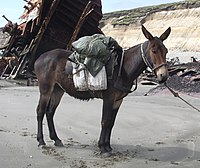
Photo from wikipedia
Abstract Mangrove plants comprise plants with similar ecological features that have enabled them to adapt to life between the sea and the land. Within a geographic region, different mangrove species… Click to show full abstract
Abstract Mangrove plants comprise plants with similar ecological features that have enabled them to adapt to life between the sea and the land. Within a geographic region, different mangrove species share not only similar adaptations but also similar genetic structure patterns. Along the eastern coast of South America, there is a subdivision between the populations north and south of the continent's northeastern extremity. Here, we aimed to test for this north‐south genetic structure in Rhizophora mangle, a dominant mangrove plant in the Western Hemisphere. Additionally, we aimed to study the relationships between R. mangle, R. racemosa, and R. × harrisonii and to test for evidence of hybridization and introgression. Our results confirmed the north‐south genetic structure pattern in R. mangle and revealed a less abrupt genetic break in the northern population than those observed in Avicennia species, another dominant and widespread mangrove genus in the Western Hemisphere. These results are consistent with the role of oceanic currents influencing sea‐dispersed plants and differences between Avicennia and Rhizophora propagules in longevity and establishment time. We also observed that introgression and hybridization are relevant biological processes in the northeastern coast of South America and that they are likely asymmetric toward R. mangle, suggesting that adaptation might be a process maintaining this hybrid zone.
Journal Title: Ecology and Evolution
Year Published: 2018
Link to full text (if available)
Share on Social Media: Sign Up to like & get
recommendations!